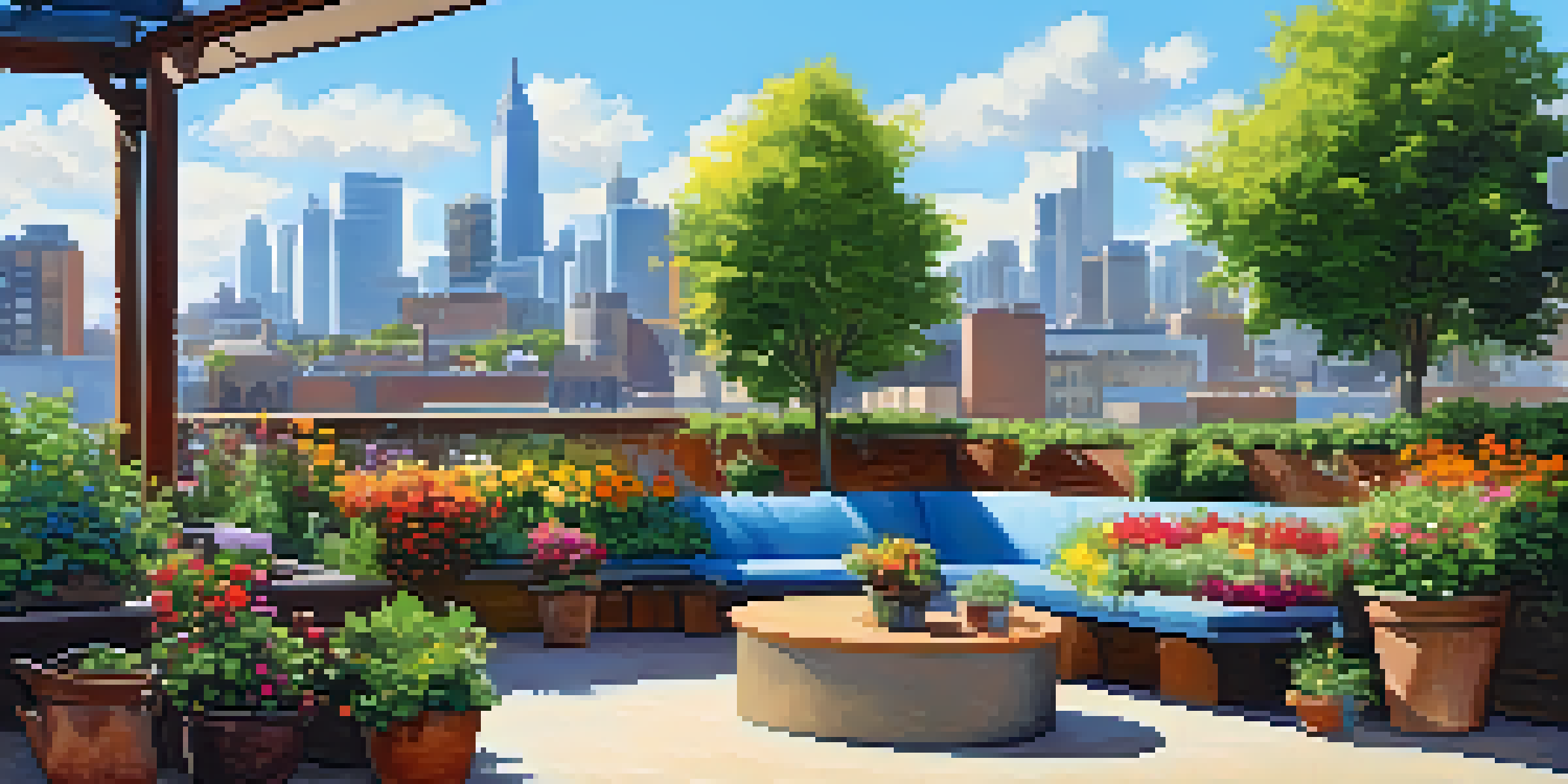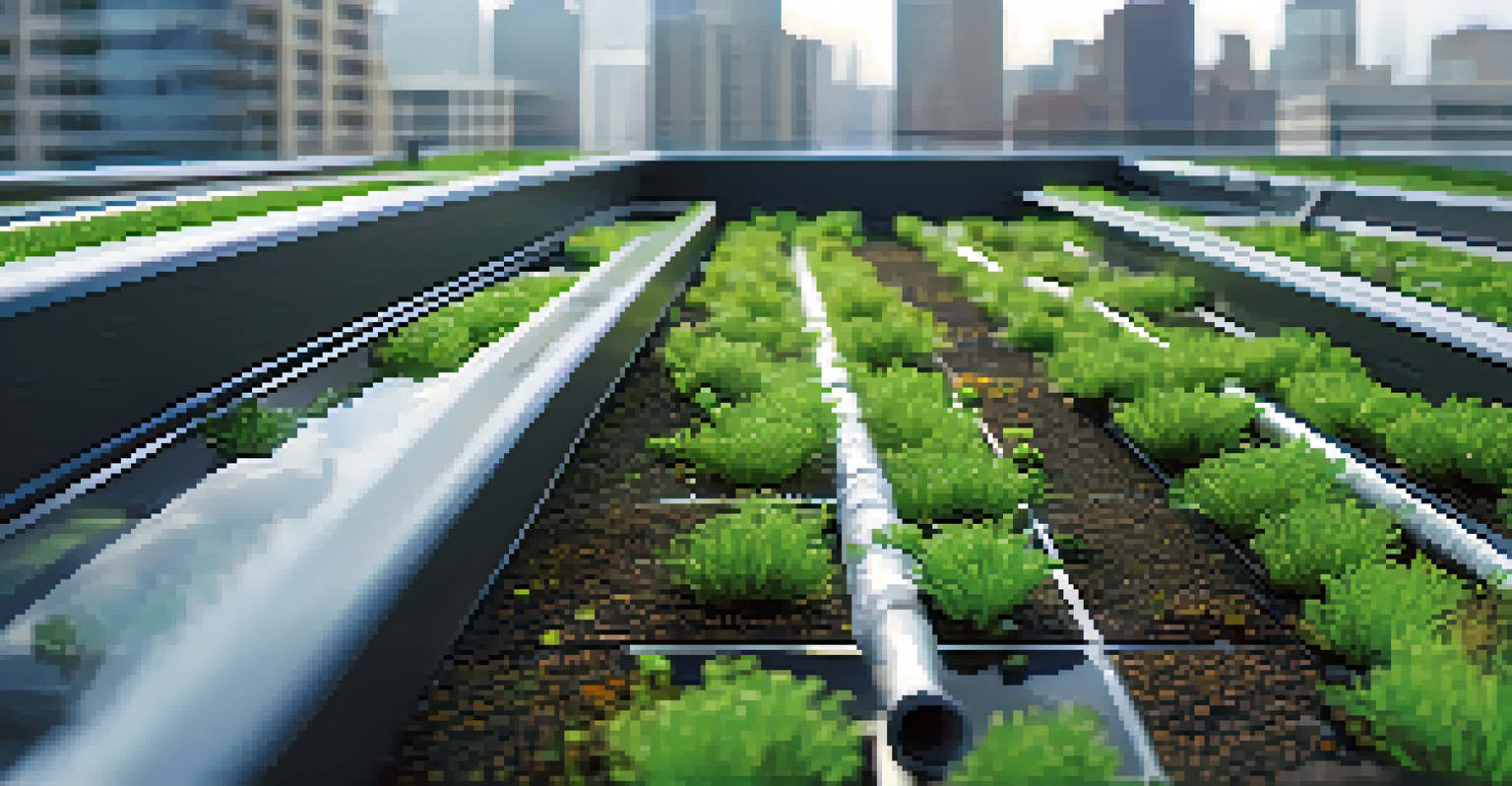Green Roofs: A Creative Solution for Urban Spaces

What Are Green Roofs and Why Do They Matter?
Green roofs, also known as living roofs, are layers of vegetation planted on rooftops. They not only create a beautiful oasis in the concrete jungle, but they also offer numerous environmental benefits. By absorbing rainwater, they help reduce urban flooding and improve air quality, making cities more livable.
The green roof is a way to create a living and breathing building, where nature and architecture can coexist harmoniously.
Imagine walking through a city where the rooftops are lush with greenery instead of dull gray. This transformation can significantly reduce the heat island effect that plagues many urban areas, where buildings and pavements absorb and retain heat. Green roofs cool down the surrounding air, promoting a more comfortable environment.
Moreover, green roofs can play a crucial role in biodiversity. They provide habitats for birds, insects, and other wildlife, helping to restore a sense of nature in heavily developed areas. In short, they are more than just an aesthetic upgrade; they are a vital part of urban ecology.
The Environmental Benefits of Green Roofs
One of the standout features of green roofs is their ability to manage stormwater effectively. By absorbing rainwater, they reduce runoff and lessen the burden on drainage systems. This leads to lower flood risks and minimizes the chances of water pollution entering local waterways.

Additionally, green roofs help to improve air quality. Plants naturally filter pollutants and carbon dioxide, releasing oxygen in return. This not only benefits the environment but also enhances the health and well-being of urban inhabitants, contributing to cleaner air in bustling cities.
Green Roofs Enhance Urban Ecology
Green roofs provide vital environmental benefits, such as improving air quality, managing stormwater, and promoting biodiversity in urban areas.
Furthermore, they provide thermal insulation, helping to regulate building temperatures. This can lead to energy savings, as less energy is needed for heating and cooling. In essence, green roofs serve as a multi-functional solution that addresses several environmental challenges simultaneously.
Economic Advantages of Implementing Green Roofs
While the initial investment for green roofs may be higher than traditional roofing, the long-term savings can be significant. Reduced energy costs, lower stormwater management fees, and potential tax incentives can all contribute to a healthier bottom line for property owners. Over time, these roofs can even increase property values.
Green roofs are a way to integrate nature into the urban fabric, creating spaces that are not only beautiful but also beneficial to the environment.
Moreover, green roofs can enhance the appeal of commercial spaces, attracting more customers. Imagine sipping coffee on a rooftop garden, surrounded by flowers and greenery rather than concrete. This unique environment can serve as a marketing tool, helping businesses stand out in the competitive urban marketplace.
In addition to direct economic benefits, green roofs can also create job opportunities in the fields of landscape architecture, horticulture, and maintenance. This helps foster a greener economy while contributing to community growth and sustainability.
Types of Green Roofs: Extensive vs. Intensive
Green roofs generally fall into two categories: extensive and intensive. Extensive green roofs are lightweight, requiring minimal maintenance and a shallow layer of soil, making them ideal for residential buildings. They typically feature hardy plants such as sedums and grasses that can thrive in harsher conditions.
On the other hand, intensive green roofs are akin to rooftop gardens, with deeper soil layers that support a wider variety of plants, including shrubs and small trees. These roofs require more maintenance and care but offer greater aesthetic and functional possibilities, such as urban farming or recreational spaces.
Economic Benefits of Green Roofs
Despite higher initial costs, green roofs can lead to long-term savings through reduced energy expenses and increased property values.
Choosing the right type of green roof depends on various factors, including building structure, climate, and intended use. Understanding these distinctions is crucial for anyone considering integrating greenery into their urban space.
Design Considerations for Green Roofs
Designing a green roof involves careful planning and consideration of various factors. This includes selecting appropriate plant species, ensuring proper drainage, and creating an effective irrigation system. Each of these elements plays a vital role in the roof's success and longevity.
Additionally, the roof's structural integrity must be assessed to support the added weight of soil and plants. Collaborating with architects and engineers experienced in green roof design can help navigate these complexities and ensure a successful installation.
Moreover, aesthetic appeal should not be overlooked. Thoughtful design can create inviting spaces that encourage outdoor activities and enhance overall well-being, turning unused rooftops into vibrant community hubs.
Challenges in Implementing Green Roofs
Despite their many benefits, green roofs come with challenges that can deter implementation. Initial costs, ongoing maintenance, and structural concerns can pose significant obstacles for property owners. However, understanding these challenges is the first step towards overcoming them.
Weather conditions can also affect the viability of certain plants. In some regions, extreme temperatures or drought can hinder plant growth, necessitating careful selection of resilient species. Additionally, ongoing maintenance, such as weeding and irrigation, is essential for ensuring the roof remains healthy and vibrant.
Challenges in Green Roof Implementation
While green roofs offer numerous advantages, challenges like initial costs, maintenance, and regulatory hurdles can complicate their adoption.
Lastly, there can be regulatory hurdles, such as zoning laws or building codes, that complicate the green roof installation process. Engaging with local government and stakeholders early in the planning phase can help navigate these challenges and pave the way for successful projects.
The Future of Green Roofs in Urban Planning
As cities continue to grow, integrating green roofs into urban planning will become increasingly important. Many cities are recognizing the need for sustainable solutions to combat climate change and improve quality of life for residents. Green roofs offer a viable and attractive option for achieving these goals.
Innovative technologies, such as smart irrigation systems and modular green roof systems, are making it easier to implement and maintain these living roofs. These advancements can enhance efficiency, reduce costs, and promote wider adoption among urban developers and homeowners alike.

Ultimately, the future of green roofs lies in collaboration. By working together—city planners, architects, and community members—we can create greener, healthier urban spaces that benefit everyone. Embracing this approach will not only enhance the beauty of our cities but also contribute to a more sustainable future.